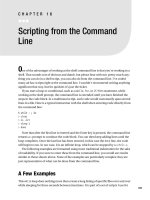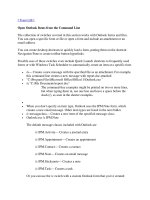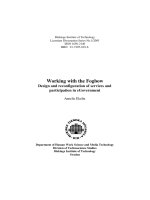Working with linux quick hacks for the command line
Bạn đang xem bản rút gọn của tài liệu. Xem và tải ngay bản đầy đủ của tài liệu tại đây (21.37 MB, 275 trang )
Working with Linux – Quick Hacks for the
Command Line
Table of Contents
Working with Linux – Quick Hacks for the Command Line
Credits
About the Authors
www.PacktPub.com
eBooks, discount offers, and more
Why subscribe?
Customer Feedback
Preface
What this book covers
What you need for this book
Who this book is for
Conventions
Reader feedback
Customer support
Errata
Piracy
Questions
1. Introduction
Are you ready?
Terminator – the ultimate terminal
Preferences menu
Features
Guake – not Quake!
ClipIt – copy-paste at its finest
2. Productive Shells – Reinvent the way you work
Oh-my-zsh – your terminal never felt this good before!
Basic regular expressions
Pipes and subshells – your shell's salt and pepper
Shell scripting for fun and profit
Shell scripting libraries
3. Vim kung fu
Supercharging Vim
Color scheme desert
Keyboard kung fu
Plugin steroids for Vim
Vim password manager
Instant configuration restoring
4. CLI – The Hidden Recipe
Sed – one-liner productivity treasure
You can run, but you can't hide… from find
tmux – virtual consoles, background jobs and the like
Network – Who's listening?
Autoenv – Set a lasting, project-based habitat
Don't rm the trash
5. Developers' Treasure
The spot webserver
Shrinking spells and other ImageMagick
Go with the Git flow
Merging Git conflicts with ease
From localhost to instant DNS
JSON jamming in the new age
No more mister nice guy
6. Terminal Art
Index
Working with Linux – Quick Hacks for the
Command Line
Working with Linux – Quick Hacks for the
Command Line
Copyright © 2017 Packt Publishing
All rights reserved. No part of this book may be reproduced, stored in a retrieval system, or
transmitted in any form or by any means, without the prior written permission of the publisher, except
in the case of brief quotations embedded in critical articles or reviews.
Every effort has been made in the preparation of this book to ensure the accuracy of the information
presented. However, the information contained in this book is sold without warranty, either express
or implied. Neither the authors, nor Packt Publishing, and its dealers and distributors will be held
liable for any damages caused or alleged to be caused directly or indirectly by this book.
Packt Publishing has endeavored to provide trademark information about all of the companies and
products mentioned in this book by the appropriate use of capitals. However, Packt Publishing cannot
guarantee the accuracy of this information.
First published: May 2017
Production reference: 1260517
Published by Packt Publishing Ltd.
Livery Place
35 Livery Street
Birmingham B3 2PB, UK.
ISBN 978-1-78712-918-4
www.packtpub.com
This book was downloaded from AvaxHome!
Visit my blog with more new books:
/>
Credits
Author
Petru Ișfan
Bogdan Vaida
Commissioning Editor
Kartikey Pandey
Acquisition Editor
Prachi Bisht
Content Development Editor
Prachi Bisht
Trusha Shriyan
Technical Editor
Naveenkumar Jain
Copy Editors
Safis Editing
Project Coordinator
Kinjal Bari
Proofreader
Safis Editing
Indexer
Aishwarya Gangawane
Graphics
Kirk D'Penha
Production Coordinator
Melwyn Dsa
Cover Work
Melwyn Dsa
About the Authors
Petru Ișfan is a full-stack developer, Linux evangelist, open source lover, and cloud pioneer. Petru
has worked all his engineering life in Linux, and has tried all the major distributions out there. He
specializes not only in software development, but in the whole software engineering stack, focusing
on tools and workflows that enhance developer productivity and enjoyment.
An early adopter of technology, he uses passion and best practices to deliver software products,
mainly for the Web and the mobile world, working with clients big and small. He is really
enthusiastic about finding the most efficient and elegant solutions for all problems.
Bogdan Vaida burst onto the training scene in 2009 using extremely old Powerpoint presentations.
Luckily, two years later, he switched to experiential training and learning by using methodologies that
he practiced devotedly in all of his training. Known for his no-nonsense approach to getting results,
Bogdan has been told that he helps participants get their own "insanely practical insights."
What does he do? He travels around the world doing experiential training in fields ranging from
video editing to personality typologies and trainer training. While doing this, he also manages his
online courses, which have over 10,000 students from all over the world.
In 2015, he beat the record for total time spent in airports.
www.PacktPub.com
eBooks, discount offers, and more
Did you know that Packt offers eBook versions of every book published, with PDF and ePub files
available? You can upgrade to the eBook version at www.PacktPub.com and as a print book
customer, you are entitled to a discount on the eBook copy. Get in touch with us at
<> for more details.
At www.PacktPub.com, you can also read a collection of free technical articles, sign up for a range
of free newsletters and receive exclusive discounts and offers on Packt books and eBooks.
/>Get the most in-demand software skills with Mapt. Mapt gives you full access to all Packt books and
video courses, as well as industry-leading tools to help you plan your personal development and
advance your career.
Why subscribe?
Fully searchable across every book published by Packt
Copy and paste, print, and bookmark content
On demand and accessible via a web browser
Customer Feedback
Thanks for purchasing this Packt book. At Packt, quality is at the heart of our editorial process. To
help us improve, please leave us an honest review on this book's Amazon page at
/>If you'd like to join our team of regular reviewers, you can e-mail us at
We award our regular reviewers with free eBooks and videos in
exchange for their valuable feedback. Help us be relentless in improving our products!
Preface
Our mission is to save Linux users from their unproductive habits.
In this book, you will learn:
What's one of the best terminals to use (just a hint: you need that split screen functionality).
How clipboard managers memorize the things you copy, so you don't have to.
How to use the greatest/biggest/most intelligent :)) console editor since humankind appeared.
Yes, it's Vim. And we'll dive deep into its usefulness.
Zsh and its awesome oh-my-zsh framework featuring over 200 plugins for developers and
productivity seekers.
Extensive lessons on terminal commands: how to find and replace text, parts of text, tiny bits of
text or even non-text.
How to use pipes and subshells to create customized commands that automate day-to-day tasks.
And much more. This book is for all the programmers that are new to the Linux environment.
But who are we?
Petru: the infamous coder with many years of Linux experience. He types like crazy, loves doughnuts
and has Linux wired in his brain! After discovering Linux and switching through a different
distribution every week, annoying his girlfriend with tons of geeky stuff, now he annoys everybody
with geek talks and the latest news in the tech world.
He spends his time coding frontends, backends, databases, Linux servers, and clouds.
Bogdan: the deserter! He went through more than 20 Linux and Unix distributions including Plan 9,
HP-UX and all of the BSDs. But after his girlfriend left him because he spent way too much time in
front of the computer he… switched to Mac.
Now he spends his time teaching over ten thousand students in his 8 online courses.
And we are here to help you double your terminal productivity!
If you don't know how to use sed, if you're not that used to pipeing commands, if you use the default
terminal and if you are still using BASH then this book is for you.
Read it now and double your terminal productivity!
What this book covers
Chapter 1, Introduction, introduces the most basic tools needed to transform your user experience.
Chapter 2, Productive Shells – Reinvent the Way You Work, reinvents the way you work. Colors,
editors, and custom configurations all tailored to your custom needs.
Chapter 3, Vim kung fu, explains the way of the terminal warrior. This includes configuration and
advanced usage to cover the majority of needs.
Chapter 4, CLI – The Hidden Recipe, shows different ways of going from good to great and boosting
the command-line capabilities to new frontiers.
Chapter 5, Developers' Treasure, explains how to maximize productivity with these simple hacks. It's
the small things that produce the big difference.
Chapter 6, Terminal Art, prepares you to become amazed at what creativity can do with limited
resources. This is where the fun begins.
What you need for this book
Ideally, you can equip yourself with a fresh Ubuntu operating system and go through the samples
while reading. Remember there is a git repository available at />Go ahead and clone this locally so that you can use the project's sample files.
Who this book is for
This book is for Linux users who already have some form of basic knowledge and are looking to
improve their skills and become more productive in the command-line environment. It is for users
who want to learn tips and tricks that master's use, without going through all the trials and errors in
the vast open source ocean of tools and technologies. It's for the users who want to feel at home at the
terminal prompt and are eager to do the vast majority of tasks from there.
Conventions
In this book, you will find a number of text styles that distinguish between different kinds of
information. Here are some examples of these styles and an explanation of their meaning.
Code words in text, database table names, folder names, filenames, file extensions, pathnames,
dummy URLs, user input, and Twitter handles are shown as follows: "Open the terminator and type
sudo apt install zsh to install zsh, as shown in."
A block of code is set as follows:
case ${CMD} in
publicip)
print_public_ip
;;
ip)
IFACE=$(getarg iface $@)
print_ip $IFACE
;;
*)
echo "invalid command"
esac
Any command-line input or output is written as follows:
sh -c "$(curl -fsSL />
New terms and important words are shown in bold. Words that you see on the screen, for example,
in menus or dialog boxes, appear in the text like this: "Go to shell and enable Open new tab in
current directory."
Note
Warnings or important notes appear in a box like this.
Tip
Tips and tricks appear like this.
Reader feedback
Feedback from our readers is always welcome. Let us know what you think about this book—what
you liked or disliked. Reader feedback is important for us as it helps us develop titles that you will
really get the most out of.
To send us general feedback, simply e-mail <>, and mention the book's title
in the subject of your message.
If there is a topic that you have expertise in and you are interested in either writing or contributing to
a book, see our author guide at www.packtpub.com/authors.
Customer support
Now that you are the proud owner of a Packt book, we have a number of things to help you to get the
most from your purchase.
Errata
Although we have taken every care to ensure the accuracy of our content, mistakes do happen. If you
find a mistake in one of our books—maybe a mistake in the text or the code—we would be grateful if
you could report this to us. By doing so, you can save other readers from frustration and help us
improve subsequent versions of this book. If you find any errata, please report them by visiting
selecting your book, clicking on the Errata Submission
Form link, and entering the details of your errata. Once your errata are verified, your submission will
be accepted and the errata will be uploaded to our website or added to any list of existing errata
under the Errata section of that title.
To view the previously submitted errata, go to and
enter the name of the book in the search field. The required information will appear under the Errata
section.
Piracy
Piracy of copyrighted material on the Internet is an ongoing problem across all media. At Packt, we
take the protection of our copyright and licenses very seriously. If you come across any illegal copies
of our works in any form on the Internet, please provide us with the location address or website name
immediately so that we can pursue a remedy.
Please contact us at <> with a link to the suspected pirated material.
We appreciate your help in protecting our authors and our ability to bring you valuable content.
Questions
If you have a problem with any aspect of this book, you can contact us at
<>, and we will do our best to address the problem.
Chapter 1. Introduction
This book is split into multiple parts. In part 1, we'll explore a new terminal and show you how to
install and configure it. In part 2, we will concentrate on configuring your shell, adding plugins,
understanding regular expressions, and working with pipes and subshells. Everything will then be
coagulated into a shell scripting lesson. In part 3, we'll work with Vim, our recommended editor. We
will cover everything from configuring it, to learning keyboard shortcuts, installing plugins, and even
using it as a password manager. So let's get started.
In the following chapter, we will learn the following topics:
Understanding the working of Terminator
Using Guake for your quick commands or long running tasks
Using ClipIt to copy-paste text
So, we will start with a terminal after which everything will be wild! When it comes to working long
hours in a terminal, our choice is to use Terminator for its fast and easy split screen functionality.
Then, we will focus on Guake, a terminal that opens really fast and wherever you are. Towards the
end, you will understand the working of Clipit and use its copy and paste feature effectively.
Are you ready?
We will dive deep into the Linux environment, giving you tips and tricks to increase your
productivity, make you more comfortable with the command line, and automate your tasks.
The book is based on Ubuntu Linux version 16.04, which is the latest long-term support version. We
chose Ubuntu because it's the most common Linux distribution out there, it's really simple to use, has a
lot of graphical tools, and you can find a huge online community ready to answer all your questions.
Ubuntu is also the most supported Linux distribution. This means that companies that create software,
especially graphics software, and offer them for Linux, usually start with Ubuntu.
This makes it easier for us to use tools such as Skype, Slack, or Visual Studio Code. Although the
book is based on Ubuntu, most of the commands are not related to Ubuntu, so you can easily use
another distribution and apply the same lessons. A large part of the book can even be applied
applicable to Mac, as we can have the same tools installed on Mac — bash, zsh, vim all work the
same way across Linux and Mac--and with the release of Windows 10, bash support is built in, so
tools such as zsh and vim can easily be installed and used. Before Windows 10, there were tools such
as cygwin that let you use the Linux command line in a Windows environment.
We recommend you to read and practice in an open terminal so that you can execute the commands
and check their results. Before we start, you want to download all the source files from our GitHub
repository (located here: />









![Tài liệu Beginning the Linux Command Line [Apress 2009] ppt](https://media.store123doc.com/images/document/13/ce/kn/medium_zPbk2szWHh.jpg)